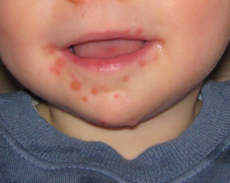 Hand, foot and mouth disease (HFMD) is a human syndrome caused by intestinal viruses of the picornaviridae family. Coxsackievirus A16 and Enterovirus 71 (EV-71) are the most common strains known to cause HFMD, but many other strains of coxsackievirus or enterovirus are known to cause this viral syndrome.
Hand, foot and mouth disease (HFMD) is a human syndrome caused by intestinal viruses of the picornaviridae family. Coxsackievirus A16 and Enterovirus 71 (EV-71) are the most common strains known to cause HFMD, but many other strains of coxsackievirus or enterovirus are known to cause this viral syndrome.
HFMD is a common and highly contagious viral infection that typically causes a mild febrile illness followed by a maculopapular rash that may involve the skin of the hands, feet, and oral cavity. HFMD is fairly common and typically affects infants and children, but may affect immunocompetent adults on occasion.The viruses that cause HFMD are spread through direct contact with the mucus, saliva, or feces of an infected person. HFMD typically occurs in small epidemics in nursery schools or kindergartens, usually during the summer and autumn months. The usual incubation period is 3–6 days.
HFMD should not be confused with foot-and-mouth disease (also known as hoof-and-mouth disease), a distinct viral disease known to affect sheep, cattle, and swine (both diseases are caused by members of the picornaviridae family) but transmission to humans is exceptionally rare. Most cases of the syndrome go away on their own and require no treatment other than to provide symptomatic relief. There is no cure or vaccine currently available for HFMD but one is under development.